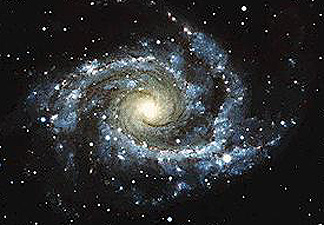
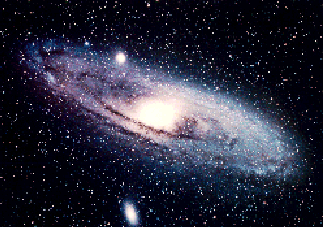
Over the next 1000 seconds, during the Nucleosynthesis Era, the predominant process was the production of stable nuclei of hydrogen and helium. Some of the protons (p+) and electrons (e-) that survived initial annihilation combined to produce new neutrons (n) by weak force interactions, which added to the supply of remaining hadronic neutrons. During this stage, thermonuclear fusion commenced, yielding a detonation referred to as the primordial fireball on a grandiose scale that is just hinted at by a hydrogen bomb's explosion. As temperatures dropped below 109 K (at ~ 3 minutes), neutrons captured available protons (hydrogen nuclei) to form deuterium (heavy hydrogen) nuclei; all primordial deuterium (actually, at the time, a deuteron or H2 nucleus) was created in the first minutes of the Big Bang but younger helium is subsequently being both created and destroyed in star fusion (presently, ~1 deuterium atom per 30000 hydrogen atoms is the survival ratio) . Reaction between deuterons and protons can produce helium (He3) ; in turn, two He3 nuclei can combine to form the heavy helium isotope (He4) plus released protons. This brief era witnessed the synthesis of the primordial nuclear constituents -- ~90% hydrogen/deuterium and 10% helium by numbers of particles and 75-25% by mass that make up the two elements subsequently dominating the Universe , along with minute amounts of lithium. Most helium was produced at this early time, but younger helium is also the product of hydrogen burning in stars; the ratio of He/H has remained nearly constant because about as much new He is then created as converted to heavier elements during stellar evolution. The hydrogen nuclei generated in this critical time span later became the basic building material for stars, which are the sites of the internal stellar nucleosynthesis (fusion) that eventually spawned the elements with atomic numbers (symbol = Z, whose value is the unique number of protons in the nucleus of a given element) up to 26 (Fe or iron); these account for the dominant elements, in terms of both mass and frequency, in the Universe (elements with Z > 26 are produced in other ways, as described later).
As the fireball subsided with continuing Universe expansion, the matter produced was dispersed in a still very dense "soup" of predominantly x-ray photon radiation along with neutrinos and nucleons and other elementary particles (a mix of ionized nuclei and free electrons known as a plasma). None of the chemical elements with mass numbers greater than 2 (helium) had come into existence at this stage (they originated later by being synthesized in stars). The time that lasted from after the first fifteen minutes to about 10,000 years (cosmic time, i.e., since the moment of the Big Bang) is known as the Radiation Era (connoting the dominance of electromagnetic radiation) . The Universe during this stage was opaque ("fog") because radiation was prevented from leaving its confines owing to internal scattering by free electrons. As expansion proceeded, the mass-equivalent radiation density (E = mc2 equivalency) decreased as mass density increased (today, mass density greatly exceeds radiation density even though the number of photons [individually, almost massless] is much larger [in a ratio of ~1 billion photons to every baryon]). So, by the first 10,000 years, the Universe had started to become mass-dominated. This radiation era ended with the onset of the Decoupling Era, at which stage cooling had dropped below 3,000 K, allowing protons and helium nuclei to combine with electrons forming hydrogen and helium atoms. As this stage (also known as the Recombination Era) began, the Universe was about 1/200th its present size. The decreased numbers of free electrons reduced scattering to the extent that the opaque Universe now became transparent to radiation (allowed photons to pass through), even as interstellar space, which is a near-vacuum, became black, i.e., does not give off luminous self-radiation but does contain very low densities of photons and other particles (about 3 atoms per cubic meter), and does facilitate free passage within any region of radiation from external sources. This era is estimated to have lasted up to 300,000 years (generally accepted value) to perhaps as long as the first million years.
As the dispersing mix of H and He atoms, photons, and other particles continued to expand (thereby progressively decreasing in density), it eventually cooled to temperatures around a few degrees Kelvin. (see Cosmic Background Radiation on page Cosmo-5). Large-scale variations (called fluctuations or seed perturbations) in mass and energy density, whose origin can be traced to the early moments of the Big Bang, occurred at random throughout the enlarging Universe. In regions of density increase as small as <1%, gravitational forces acting between the innumerable constituents led to attractions that built up regions marked by slightly greater concentrations of matter (still mostly hydrogen and helium). Variations in radiation pressures also contributed to the process, at times countering the gravity-induced densification. With time, these clots grew more dense (up to 5% overdense) as they continued to draw in (by attraction) matter from their surroundings. Many clots eventually collapsed into vast nebulae ("clouds") from which galaxies were initiated. A galaxy is an organized concentration or clumping of stars (but individuals still widely separated from one another by distances measured in tens of light years) in an aggregate containing billions of discrete stars. Typical maximum dimensions of a galaxy range from 80,000 to 150,000 light years in diameter.
As early as 1 million years (m.y.) (cosmic time; measured from the moment of the Big Bang) and perhaps as far back as the early Decoupling Era, but especially in the first billion years, protogalaxies (incipient or first stage galaxies) began to organize on a grand scale (by a set of processes beyond the scope of this review). These evolved over time into fullblown galaxies, consisting of stars (localized spherical clots of gas [initially H and some He] that contract and heat up to interior temperatures > 106 K, thereby becoming luminous [radiant] bodies).Amazingly, despite the huge number of stars in a galaxy, most of space is interstellar and, even more so, intergalactic, with individual stars in a galaxy being widely separated (a scale analogy: if a star is represented by a marble just 1 centimeter in diameter, the average distance to its nearest neighbor stars is around 300 kilometers). All stars together (totaled for all galaxies) comprise just about 1 part per million of Universal space: thus in the total volume of observable space, "void" dominates and luminous objects are an exceedingly small part (far less than one might expect by looking through a telescope in which much of the field of view seems occupied by points of light [galaxies or galactic clusters], since there are huge distances between them in the direction of viewing).
One model ("top down") of early galaxy evolvement considers a cloud to fragment into star groupings as it develops from hot dark (radiating but not luminous) gaseous matter. Another galactic model ("bottom up") begins the process with localized multi-star formation from cold dark (low levels of EM radiance) matter, with subsequent aggregation into fewer stars that grow mainly by collision ("cannibalism") with one another. Recent observations suggest the bottom up model describes the predominant process. Also, other surveys (especially with the Hubble Space Telescope [see below]) indicate a large number of individual stars, or small groups, with populations much below that of even the smaller galaxies, occur dispersed in intergalactic space as well as in the halo regions above and below the volumes of space containing the bulk of the stars in the galaxies themselves. Thus, star formation is a general process (see next page) that can take place wherever widespread to local concentrations of hydrogen gas produce clouds of matter of sufficient density to initiate gravitational contractions.
A common type of clustered stars is the spiral galaxy, seen here in both top and edge views. This type consists of stars arranged in a flattened disc wherein younger (blue) stars are strung out in several prominent spiraling arms that emanate from a central nucleus


comprised of a denser collection of older (yellow to orange) stars. Typical spiral galaxies are about 100,000 light years in diameter; disc thicknesses are less than 10,000 l.y. The disc shape results from a greater degree of collapse in one direction and a significant transfer of angular momentum to the disc arms as a effect of tidal (gravitational) interaction with nearby galaxies (clots of dark matter and some stars exist as a halo above and below the flattened central disc). A second type (top, below), the elliptical galaxy, contains mostly old stars (up to 1012); such a galaxy originates through collisions, tidal disruption and other interactions, often between dwarf or even major spirals. Globular star clusters (bottom) - each an aggregate of 100,000 to a million stars - are common in elliptical galaxies; Some galaxies - known as dwarf galaxies - contain as few as one hundred million stars. Thus, throughout the Universe the diversity of types and sizes of galaxies is considerable.
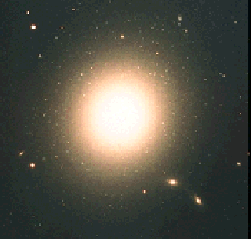
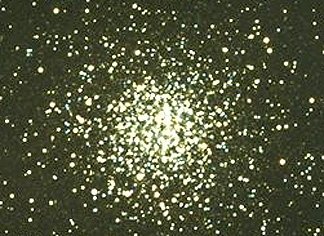
Individual galaxies of each type are separated by distances of up to
millions of light years. Despite these large separations, collisions between galaxies
(one tends to "pass" through the other) have been
observed and may well be common. Galaxies tend to be grouped in great clusters or even
superclusters (collections of proximate clusters) arranged commonly
in elongated bands or strings that began aligning about 1-2 billion
years after time zero. The elliptical galaxies are more abundant than
spiral in these superclusters. Intergalactic space between superclusters
contains lower numbers of galaxies, in regions the decrease may
be so sharp as to warrant the term "voids". The diagram below
displays the distribution of approximately 2500 bright galaxies within a 10 Mpc thick wedge of outer space extending
out to 300 Megaparsecs (Mpc) over a declination ranging between 26.5° and 44.5° (a parsec
is a distance measure based on parallax methods; it is ~3.26 light years).
This survey is part of an on-going sky count being made by Margaret Geller and associates of Harvard's
Center for Astrophysics. The plot clearly indicates that many galaxies organize along distinct linear
clusters described as "filaments". Some volumes of space have low populations of clusters, indicating
voids. The reason for clustering is still uncertain but probably is set up by variations in matter distribution
during the early stages of expansion (perhaps even extending back to fluctuations during the
inflationary period in the early fractions of the first cosmic second).
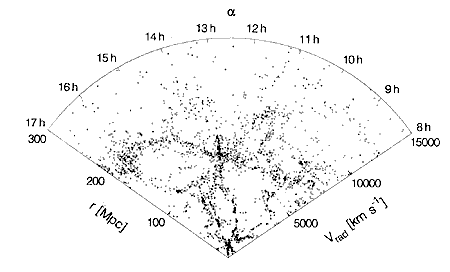
The total number of galaxies spread more or less uniformly across the Universe is not known, with any degree of certainty - no one has yet attempted to count the myriads that appear to exist. Estimates can be made by sampling segments of the observable Universe and then extrapolating throughout the celestial sphere encompassing the Earth. However, be advised that the outer reaches of the observable Universe have yet to be seen, if indeed one can imagine such limits (there is no proof or reasonable assumption that demands the Universe to be bounded or finite). Plausible estimates hold the number of galaxies to be on the order of 100 billion (1011) and the number of stars contained in typical galaxies to be of similar magnitudes (small galaxies with only a few billion stars do exist). Most galaxies are very old (the bulk had organized in the first two billion years after the Big Bang) but some are younger and a small fraction may even have started forming in the last few billion years.
The Solar System is embedded in a spiral galaxy (our star, the Sun, born about 5 b.y. ago, is positioned about 3/5ths out [about 28000 light years] from the galactic center which lies visually within the constellation Sagittarius as a backdrop). As seen from Earth the rest of the galaxy, with its high density of nearby stars (closest to the Sun is Alpha Centauri, 4 l.y. away), is named colloquially the "Milky Way" (because the disc in which we are embedded resembles a diffuse "milk"-like band across the night sky). Age estimates for the Milky Way's inception fall around 10 billion years. Like most spiral galaxies, the bulk of the stars occurs within the spiral disc, with the maximum number in the central region. But lower numbers are found in a "halo" that extends above and below the disc. These are tied gravitationally to the galaxy (which itself maintains its integrity of motion - and stays together - owing to a great deal of mass, most of it invisible or non-luminous). A large part of the Milky Way is imaged in this infrared view obtained by the COBE (Cosmic Background Explorer) satellite (described on page Cosmo-5 of this subsection).
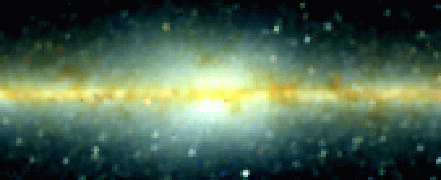
The number of stars in the Milky Way exceed 10 billion and may be much higher. A recent image of just a tiny segment (13 light years wide)
near the center of the Milky Way (in the vicinity of the Sagittarius constellation) was obtained by the Hubble Space Telescope (see below), as seen here.
Our galaxy-a part of the Virgo supercluster (containing about 250 large galaxies and up to a 1000 more smaller ones) -probably was born about 9 b.y ago. The closest neighboring spiral galaxy, Andromeda, is located about 225,000 l.y. distant. Much closer are two irregular satellite galaxies - the Large and Small Magellanic clouds - that are about 50 Kpc (16,300 light years) away. All of these galaxies are moving (separating) relative to each other. Spiral galaxies slowly rotate; the Milky Way completes one full revolution about its center in 200 million years.
Most "star gazers" feel more comfortable looking at the luminous bodies of the Universe -
stars and galaxies - as they appear in optical imagery. But, as the above IR image of the
Milky Way implies, there is often much more "illuminating" information about celestial bodies in
images depicting energy distribution and intensity of radiation associated with other parts of the spectrum. This was emphasized in
the multispectral images of the Milky Way shown near the beginning of the Preface to this
subsection. Two more examples - this time in the spectral region whose radiation is x-rays -
should reenforce this claim. The first image below shows the spiral galaxy M83 as it appears (in
a colorized rendition) optically. Against this are contours of varations in x-ray intensities (given
in units of keV [kilo electron volts]) as measured by the joint U.S.- German Rosat (Roentgen
Satellite) launched on June 1, 1990 to monitor the entire sky. Note the close-spaced contours
around the galaxy center, but several other x-ray "hot spots" are also evident.
Several sources or mechanisms account for this x-ray generation. Most prevalent is excitation of intragalactic gases between stars or gases between galaxies that, in the tenuous void separating the stellar bodies, are traveling at such high velocities that they represent temperatures in excess of 1,000,000 K capable of producing strong x-ray responses.
The second Rosat image portrays x-ray variations spread over the entire Coma supercluster,
comprised of well over 1000 bright galaxies, located some 300,000,000 light years away. X-ray intensities
vary from strong (color-coded in reds) to decreasingly weaker in greens to blues and purples. The interstellar
gases emitting this radiation make up about 10% of the total mass of the supercluster, along with 2%
present in the stars making up the individual galaxies as determined from optical measurements;
the remainder of the mass is presently unaccounted for after inventories across the spectrum are related to their sources, so that the
bulk of the mass is associated with dark matter (see page Cosmo-5). Thus, examining both
galaxies and intergalactic regions using radiation at wavelengths both shorter and longer than
the visible helps to quantify the distribution of the entire mass of the Universe.
A "giant leap" in optical imaging is embodied by the Hubble Space Telescope (HST). HST has provided many extraordinary views of galaxies throughout the Universe. Perhaps the most remarkable scientific tool ever put into space, the 2.4 m (primary mirror diameter) HST is the outgrowth of a concept first suggested in 1946 by Lyman Spitzer who argued that any telescope placed above Earth's atmosphere would produce significantly better imagery from outer space. Launched in April of 1990 after 20 years of dedicated efforts by more than 10000 scientists and engineers, HST failed to deliver quite the sharp pictures expected because of a fundamental mistake in grinding the shape of its primary mirror. The curvature was off by less than 100th of a millimeter but this error prevented focusing of light to yield sharp images.
In December of 1993 the Hubble was revisited by the Space Shuttle, as shown in this close-up view. At that time 5 spacewalks succeeded in installing corrective mirrors and servicing other sensors. A second repair mission in February1997 was also successful in upgrading the equipment.
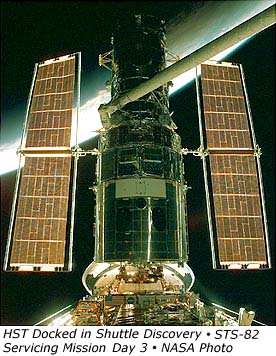
The striking improvement in optical and electronic response is evident in the pair of
images below made by the telescope, which show the famed M100 (M denotes the Messier Catalog
number) galaxy viewed by the Wide Field Planetary Camera before and after (right) the correction.
Many of the best HST images can be viewed on the Space Telescope Science Institute's home page ( http://oposite.stsci.edu/pubinfo/Pictures.html). Most galaxies formed at various times in the early history of the Universe in regions of the expanding matter where densities were somewhat higher than their surroundings. (Current thinking holds that new galaxies may be forming in the recent past and others may yet organize in the future.) HST has imaged numerous galaxies at different distances from Earth that are therefore also at different time stages in the general evolution of the Universe (see below). The following illustration shows both spiral and elliptical galaxies (but not the same individuals) at 2, 5, 9, and 14 billion years after the Big Bang in a sequence that represents different stages in this development. (Note: recent determinations of the Hubble constant [see p. cosmo-5] indicate the 14 b.y. age may be too high.)
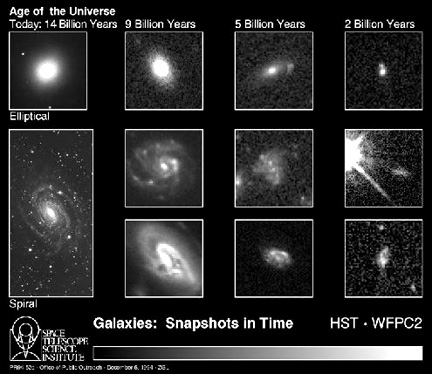
A recent release from one of the HST research
teams describes important new information on star formation within
an evolving galaxy system. Examine this pair of telescope images:

The left one is a ground-based telescope view of two colliding galaxies which together make up what is called the Antennae galaxy, so-named from the long wisps of luminous gas extending like an insect's antennae. Because of its proximity (63 million light years away), it has been a prime candidate for a closer look. The right image is a much higher resolution HST view of the central galactic mass (green box outline) of merged stars from the two once separated galaxies. The surprise is the numerous clusters of blue stars. Each appears to be groups of up to a million young (hence bright and hot) individual stars. The clusters likely are still developing, as cold hydrogen gas in giant molecular clouds (typically 100s of light years across) distributed in pockets through each galaxy are being squeezed during the collision process. They contract and heat up into individual stars as this goes on, often collapsing rapidly enough for many of the stars to explode almost like "firecrackers". Other pre-existent stars are likely to be destroyed as the collision continues. The two orange centers are the older surviving parts of each galaxy.
These observations support the growing view that collisions were a more common process in the early Universe (but still happen even now). Perhaps as many as one-third of the ancient galaxies collided during the lengthy period when galaxies were much closer, i.e., Big Bang expansion was less faralong. The usual end product of the merging of two spiral galaxies is an elliptical galaxy; many elliptical galaxies formed this way. Collisions can also give rise to spiral structure. Some globular clusters also presumably originated from collision.
Although now less common, galaxy collisions are still taking place throughout the Universe,
as illustrated by recent HST observations of the Centaurus A (NGC5128), the closest active galaxy
to our own Milky Way galaxy in which the Solar System is embedded. Centaurus A, itself
much larger than the Milky Way, is a known radiation
"hot spot", being the source of intense x-rays and radio waves.This galaxy is only 10
million light years away and thus what we see now represents its condition at 10,000,000
years prior to today.
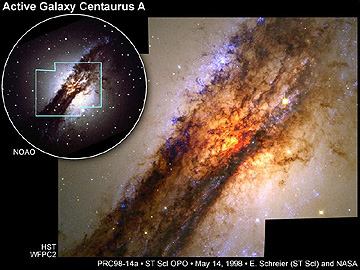
The circular inset shows Centaurus A as seen optically through a ground-based telescope. The detailed view to the right was acquired by HST's Wide Field Camera. An elongate disc, marked by dark dust, is spread across a large white glow that is identified as an elliptical galaxy. This pairing is interpreted to be an intermingling of a spiral galaxy in collision with this elliptical galaxy. The Infrared Camera on HST can penetrate the dust to reveal a hot, turbulent mass of stars, dust and gas from the spiral galaxy falling into the core of the elliptical one, as seen in the larger view. A Black Hole (see Cosmo-3) is postulated to occur towards the center of the two interacting systems; this B.H. may be as massive as 10 billion solar masses, occupying a volume similar to our Solar System. The Black Hole is "sucking" matter from both galaxies into its growing body. This set of observations is the most detailed yet of the consequences of galactic collisions.
One model of future Universe expansion paths indicates that the nearby Andromeda spiral galaxy could come close to our Milky Way galaxy and might even collide with us. There is considerable recent evidence that a small galaxy is presently passing through the Milky Way. Known as the Sagittarius dwarf spheroidal galaxy (or Sgr), its presence has been deduced from motions of certain stars that do not fit the motions of M.W. stars in the spiral arms; also star "tails" stretch out in the galactic halo, suggesting that Sgr is in a broad orbit that has caused it to intersect the Milky Way before. The vast distances between stars keeps interactions to a minimum.
Code 935, Goddard Space Flight Center, NASA
Written by: Nicholas M. Short, Sr. email: nmshort@epix.net
and
Jon Robinson email: Jon.W.Robinson.1@gsfc.nasa.gov
Webmaster: Bill Dickinson Jr. email: rstwebmaster@gsti.com
Web Production: Christiane Robinson, Terri Ho and Nannette Fekete
Updated: 1999.03.15.